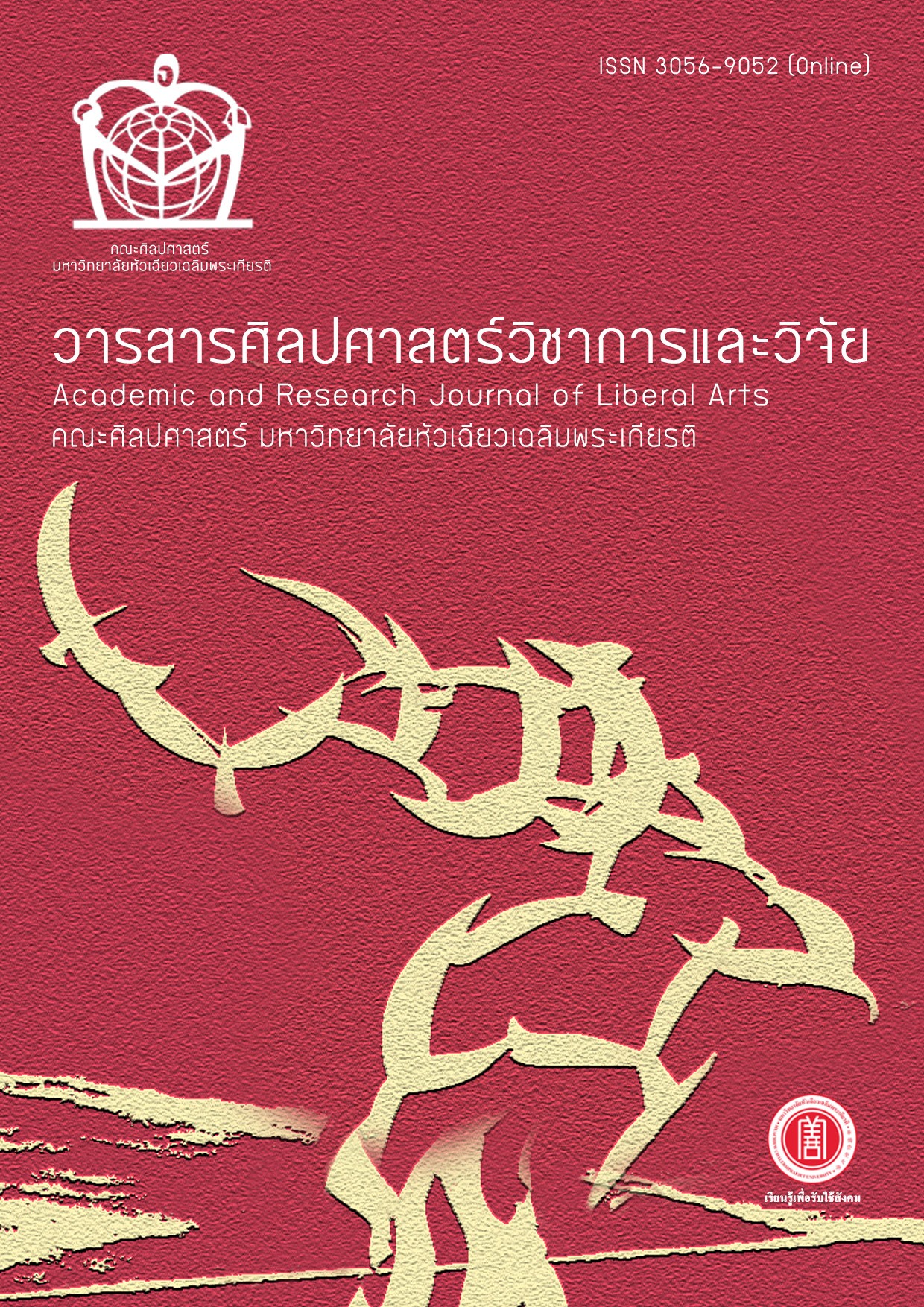The Causal Relationship of Consumer Behavior in Purchasing Products Based on Superstitious Beliefs Regarding Color Among Gen Y and Gen Z Customers
DOI:
https://doi.org/10.14456/arjla.2024.2Keywords:
Belief, Causal Relationship, Behavior in Purchasing Products, Belief in Color Selection, Attitude, Happiness, ShoppingAbstract
The objectives of this research were to study the purchasing behavior based on auspicious color beliefs between Gen Y and Gen Z and to study the customers of Gen Y and Gen Z per shopping choice with superstition as the intermediate variable. Data were collected from a sample of 304 people. Random sampling was used for the sample groups of Gen Y and Gen Z. The data were analyzed by structural equation analysis. The results showed that, in terms of motivation, buying products with auspicious colors will make customers feel lucky. There is a belief that the use of colors that are promising to oneself will be able to promote fortune. Including the attitude that beliefs influence attitudes in changing situations that occur. That causes people to buy products that are auspicious colors for themselves in various fields, including wearing clothes that are auspicious on the occasion of the day. In addition, the results of the correlation analysis found that perspectives towards superstitious attitudes have a positive direct influence on purchasing products with superstition as an intermediate variable. While credibility does not positively influence superstitions, according to the concordance validation analysis, (CMIN/DF) was 1.39, GFI was 0.95, CFI was 0.98, (RMSEA) was 0.36, and (NFI) was 0.94, which was considered consistent with the empirical data. This research reflects the important role of the business in considering improving or developing products to develop a strategy for the next generation to meet more needs.
References
สาลินี เกรียงไกร. (2556). ทัศนคติและพฤติกรรมที่มีต่อความเชื่อในเรื่องสีของผู้บริโภคในกรุงเทพมหานคร. (สารนิพนธ์การจัดการมหาบัณฑิต). มหาวิทยาลัยมหิดล, นครปฐม.
สวรส ทับทิมสุข (2564). ปัจจัยความเชื่อและทัศนคติเกี่ยวกับการทาสีเล็บ ส่งผลต่อพฤติกรรมการทำเล็บแฟชั่นของผู้บริโภคในจังหวัดชลบุรี. (วิทยานิพนธ์บริหารธุรกิจมหาบัณฑิต). มหาวิทยาลัยบูรพา, ชลบุรี.
เฉลิมชัย สุวรรณวัฒนา (2553). สีในวัฒนธรรมคติความเชื่อของไทย. (วิทยานิพนธ์ศิลปมหาบัณฑิต). มหาวิทยาลัยศิลปากร, กรุงเทพมหานคร.
ประเสริฐ ยอดแก้ว (2553). วิทยาศาสตร์ความเชื่อ. (ศิลปนิพนธ์การจัดการศิลปะบัณฑิต). มหาวิทยาลัยศิลปากร, กรุงเทพมหานคร.
Bermudez, J., and A. Cahen. (2015). Nonconceptual mental content. In E. N. Zalta (Ed.), Stanford Encyclopedia of Philosophy (Fall 2015 Edition). Stanford: The Stanford Encyclopedia of Philosophy.
Brossel, P. (2015). On the role of explanatory and systematic power in scientific reasoning. Synthese, 192, 3877–3913.
Crupi, V., & Tentori, K. (2012). A second look at the logic of explanatory power (with two novel representation theorems). Philosophy of Science, 79, 365–385.
Decock, L., & Douven, I. (2014). What is graded membership? Nous, 48, 653–682.
Douven, I., et al. (2013). Vagueness: a conceptual spaces approach. Journal of Philosophical Logic, 42, 137–160.
Fornell, C., & Larcker, D. F. (1981). Structural Equation Models with Unobservable Variables and Measurement Error: Algebra and Statistics. Journal of Marketing Research, 18, 382-388.
Gardenfors, P. (2000). Conceptual spaces–the geometry of thought. Cambridge: MIT Press.
Gardenfors, P. (2014). Geometry of meaning: Semantics based on conceptual spaces. Cambridge: MIT Press.
Hair, J. F., Black, W. C., Babin, B. J., & Anderson, R. E. (2010). Multivariate Data Analysis (7th ed.). Pearson: New York.
Hirschfeld, R.R. and Field, H.S. (2000) Work Centrality and Work Alienation: Distinct Aspects of a General Commitment to Work. Journal of Organizational Behavior, 21, 789-800.
Kline, R.B. (2011) Principles and Practice of Structural Equation Modeling. Guilford Press, New York.
Leitgeb, H. (2017). The stability of belief: how rational belief coheres with probability. Oxford: Oxford University Press.
Macpherson, F. (2015). Cognitive penetration and nonconceptual content. In J. Zeimbekis & A. Raftopoulos (Eds.), Perception and its Modalities: A Multisensory Perspective (pp. 331–358). Oxford: Oxford University Press.
Nunnally, J.C. & Bernstein, I.H. (1994). The Assessment of Reliability. Psychometric Theory, 3, 248-292.
Newen, A. (2016). Defending the liberal-content view of perceptual experience: direct social perception of emotions and person impressions. Synthese. Doi.org/10.1007/s11229-016-1030-3.
Schupbach, J., & Sprenger, J. (2011). The logic of explanatory power. Philosophy of Science, 78, 105–127.
Siegel, S. (2015). The contents of perception. In E. N. Zalta (Ed.), Stanford Encyclopedia of Philosophy. Stanford: Stanford University.
Siegel, S. (2017). The rationality of perception. Oxford: Oxford University Press.
Stokes, D. (2015). Towards a consequentialist understanding of cognitive penetration. In J. Zeimbekis & A. Raftopoulos (Eds.), Perception and its Modalities: A Multisensory Perspective (pp. 75–100). Oxford: Oxford University Press.
Downloads
Published
How to Cite
Issue
Section
License
Copyright (c) 2024 Liberal Arts Review

This work is licensed under a Creative Commons Attribution-NonCommercial-NoDerivatives 4.0 International License.
บทความที่ได้รับการตีพิมพ์เป็นลิขสิทธิ์ของวารสารศิลปศาสตร์วิชาการและวิจัย
ข้อความที่ปรากฏในบทความแต่ละเรื่องในวารสารวิชาการเล่มนี้เป็นความคิดเห็นส่วนตัวของผู้เขียนแต่ละท่านไม่เกี่ยวข้องกับมหาวิทยาลัยหัวเฉียวเฉลิมพระเกียรติ และคณาจารย์ท่านอื่นๆ ในมหาวิทยาลัยฯ แต่อย่างใด ความรับผิดชอบองค์ประกอบทั้งหมดของบทความแต่ละเรื่องเป็นของผู้เขียนแต่ละท่าน หากมีความผิดพลาดใดๆ ผู้เขียนแต่ละท่านจะรับผิดชอบบทความของตนเองแต่ผู้เดียว




